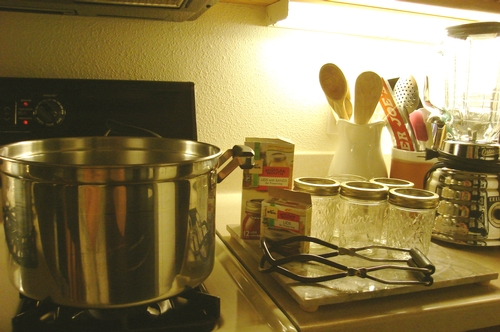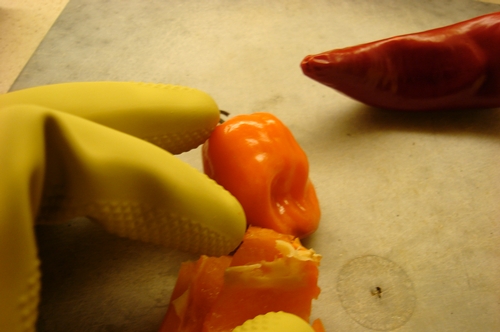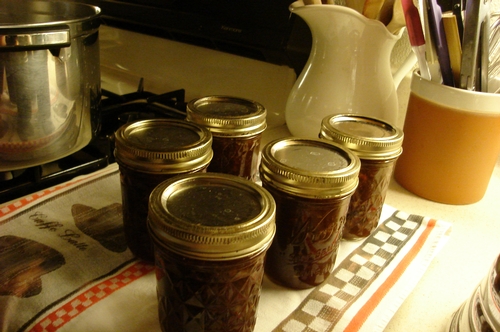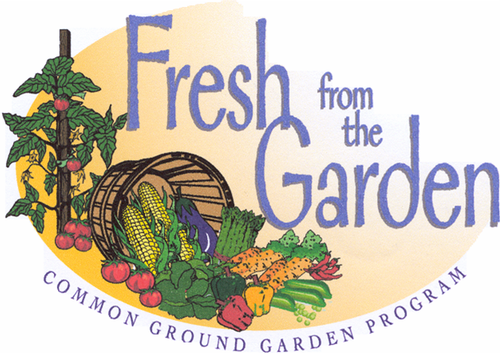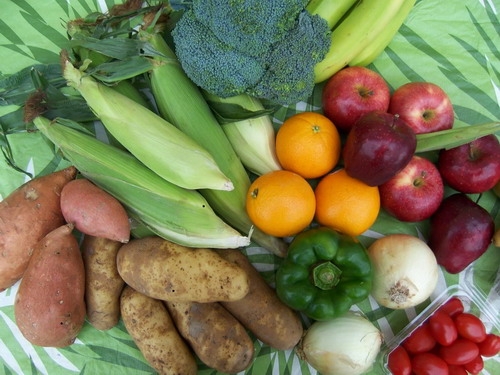Posts Tagged: vegetables
California's crop diversity is unmatched
On a recent trip to the East Coast, our first in almost 13 years, I reflected on our differing coastal experiences with agricultural diversity. Our travels took us through most of the mid-Atlantic farming region – Delaware, District of Columbia, North Carolina, Virginia, West Virginia and Pennsylvania – where we lived for almost 35 years.
We saw the familiar vast fields of corn, soybeans and alfalfa throughout most of the region. There were occasional pockets of other crops: apples, pears and grapes in the more northern parts; sorghum, sweet potatoes, peanuts and tobacco in the more southern states. We also saw occasional plots of sweet corn, green beans, oats and barley. But mostly we saw corn, soybeans and alfalfa.
We stayed at our cousins’ farm in Warriors Mark, Penn. Guess what they were growing – corn, soybeans and alfalfa. However, this year they were also growing Timothy hay for the local “hobby” horse population, as cousin Hank likes to call his high-paying customers. Our cousins have a huge vegetable garden, but do not farm vegetables because, they say: ”We can’t make any money from vegetables, they are not as profitable as the common three field crops." This seems to be the reasoning behind the tri-crop standard.
When we moved from central Pennsylvania to central California 15 years ago, we were intrigued, but mostly mystified, by the crops growing in fields near our home. With the help of new friends and colleagues, we eventually learned to identify fields of sunflowers, tomatoes, walnuts and almonds. We were astonished by the diversity of crops in our new home state, and intrigued by our lack of knowledge about crops we saw by daily. As we traveled throughout the state, our ability to identify roadside field crops grew. We saw acres of artichokes, lettuce, pistachios, figs, olives, kiwi fruit, avocados, all new as field crops to us. Using guides and manuals we found in the ANR Catalog for vegetables, fruit and nut crops, and agricultural production as well as the Fruit & Nut Research and Information Center website photo albums, we were able to identify most of what we saw. We also identified quite a few acres planted in the familiar corn and alfalfa, but hardly any soybeans.
We discovered what was growing in a nearby field when our eyes began to water and our throats close as a field of garlic was harvested. We had the same reaction to rice straw as it burned and canola harvested in a cloud of dust. The first time we saw acres and acres of sunflowers and an almond orchard in full bloom, we couldn’t help but smile. Our sense of smell also assisted in our discovery of newly harvested fields of squash, olives and tomatoes.
You can find more than the acres of corn, soybeans and alfalfa growing along the East Coast, but exceptions are usually planted in a very few acres and in limited locales. However, California’s crop diversity is readily apparent along every highway and byway in every county. Thank goodness!
Equivalent areas covered: mid-Atlantic states = 107,942,470 acres, California = 99,689,515 acres
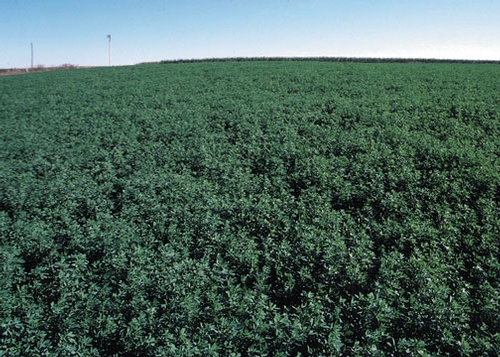
Alfalfa stretches to the horizon in the Eastern U.S. (USDA photo)
Preserving summer's bounty
As we move through the summer months, backyard gardeners everywhere are faced with the questions, "What do I do with all of these [insert vegetable or fruit here]?" followed by, "What was I thinking last spring when I planted all of this?"To the rescue is a series of free, downloadable publications from the ANR Catalog. I've always noticed that these publications move to the top of our download charts each summer, so this year I decided to try one of the recipes.
This comes from the category, "What do I do with all of these peppers?" and is actually called Peppers: Safe Methods to Store, Preserve, and Enjoy. I had some dried apricots in the pantry, so I opted for the Apricot Pepper Jelly.
The ingredients are simple enough, dried apricots, peppers, apple cider vinegar, sugar and pectin.
A lot of people think making jam is complicated and requires special equipment. It's actually quite easy. If you can read and follow directions, and have good attention to keeping things clean, making preserves is a snap. The only piece of special equipment I have purchased for canning is a jar lifter. And of course you need the jars, lids and bands. Note that while the jars and bands can be used over and over, you cannot safely re-use the lids.
I wanted my jelly to have a little extra kick, so I substituted habanero for the jalapeño called for in the recipe.
When handling hot peppers, always wear rubber gloves!
After soaking the dried apricots in hot water, they are drained, then added with the peppers and the vinegar to a food processor.
This looks like it needs a couple more pulses.
Then into the saucepan it goes, along with the sugar and pectin as directed. The recipe calls for food coloring, but since that is only for appearance, I left it out.
Less than 10 minutes later, the mixture is ready to ladle into sterilized jars.
Purists probably would not call this a jelly, as it contains small bits of the apricots and peppers.
Once all the jars are filled and capped, into the waterbath they go. The recipe contains a chart of processing times based on altitude; mine is a short 10 minutes.
After the proper processing time, lift the jars out of the waterbath. Handle them carefully with the jar lifter, as they are very hot. After a few minutes out of the hot water, you will hear the ping! ping! ping! of success as the vacuum seal is made.
An initial taste test before processing revealed a piquant flavor, so I'm going to let the flavors settle in and mellow for a couple of weeks before use. I think it will taste great with goat cheese on crackers as an appetizer, or as a glaze on baked chicken.
Also in this series are similar publications for tomatoes, cantaloupe, strawberries, garlic, oranges and apples.
UC revives “Fresh from the Garden” materials
“Fresh from the Garden” is a “vegetable education” program that was created several years ago by retired LA County Cooperative Extension employee and registered dietitian Susan Giordano. Giordano created lessons to reach home gardeners and their families living with limited resources. The lessons are designed to increase gardeners' knowledge of healthful eating habits, while emphasizing the health benefits associated with a vegetable-rich diet. The lessons also encourage gardeners to grow a greater variety of vegetables, more nutrient-dense vegetables, to cultivate vegetable crops throughout the year, and to prepare their harvest using delicious, nutritious recipes. In recent months, the lessons have been given a makeover and updated to reflect current dietary recommendations.
Bringing nutrition education into the garden
The LA County Food Stamp Nutrition Education Program (FSNEP) is partnering with UC Master Gardener volunteers this summer to pilot the revamped lessons in the garden. A group of enthusiastic Master Gardeners with an interest in nutrition education attended a “Fresh from the Garden” training on July 10. They are now equipped to take what they learned and bring it into the low-income community and school gardens where they volunteer. Our FSNEP staff members, armed with supplemental nutrition information, plan to provide additional support and expertise along the way. This is a natural fit for UC Master Gardeners who are already teaching low-income communities how to grow their own food, and UC FSNEP staff, who are providing valuable nutrition education to food stamp-eligible families. The families who benefit from these lessons will gain the knowledge and confidence they need to enjoy delicious and nutritious vegetables fresh from the garden!
“Fresh from the Garden” tips for the gardener
This time of year, gardeners are benefiting from the fruits of their labor, however, some might be overwhelmed by the sheer volume of vegetables being produced by their gardens. What to do with it all? Below is a “Fresh from the Garden” recipe for a simple summer veggie pasta sauce. Any vegetable can be substituted, and the pasta sauce can conveniently be frozen for later use.
Summer veggie pasta sauce
|
3 – 4 large tomatoes, chopped |
1 medium small onion, chopped |
|
3 cloves garlic, crushed |
1/4—1/2 cup chopped fresh basil |
|
2 medium zucchini, chopped |
2 Tablespoons oil |
|
1 small eggplant, chopped |
Salt and black pepper to taste |
|
1 medium green pepper, chopped |
|
Heat oil in a large pan over medium heat. Add onion, green pepper and garlic. Cook for 3 to 4 minutes, stirring often. Add the zucchini and eggplant. Cook for 5 minutes.
Add the tomatoes and basil. Simmer for about 20 minutes over low heat, uncovered, until slightly thick. Add salt and pepper to taste.
This recipe can be doubled or tripled and frozen in individual or family size servings. If it is not moist enough, just add water.
Interested in accessing “Fresh from the Garden” Resources? The lessons, handouts and recipes are now available on LA County's Cooperative Extension website.
For more information about “Fresh from the Garden,” please contact Los Angeles County nutrition, family & consumer sciences advisor Brenda Roche at bkroche@ucdavis.edu, (323) 260-3299.
Reasons for the seasons
California residents not only enjoy an enviable climate and diverse regions, but also a wide selection of fresh produce year around.
As consumers, we want to stretch our food budget and provide a nutritious diet to our families; but we are not always sure about how to select the best fruits and vegetables, how to store them when we get home, new ways to serve them, and the nutrition benefits they offer.
Placer-Nevada Cooperative Extension has come to the rescue! As part of the Nutrition Best program, UCCE nutrition educators have prepared "Reasons for the Seasons - Produce tips for Placer County consumers," a series of seasonal produce handouts that provide practical information for families and children on purchasing, storing, preparing and serving locally grown seasonal produce.
Each handout also includes tips for families on the importance of family meals and snacks, a couple of tasty and easy-to-prepare recipes, and a coloring page for the children.
News & Information Outreach in Spanish has started to adapt into Spanish these handouts, and produced short video clips. The first one is for strawberries.
To tickle your interest, here is a sampling of some of the tips and information you'll find:
Apples – Over 7,000 varieties have been identified, however most consumers are only familiar with half a dozen or so varieties. Munching on an apple is a tooth cleaner and a gum stimulator. Apples may last up to three months if stored correctly.
Broccoli – Its name comes from the Latin word Brachium which means "branch" or "arm." Broccoli is one of the most nutritious vegetables you can eat. Instead of loading it with a cream sauce that is high in fat, try serving it with silvered almonds, sesame seeds, toasted bread crumbs or parmesan cheese. The leaves can also be eaten and contain more beta carotene than the florets. Store broccoli in an open plastic bag in the refrigerator vegetable drawer. For boiling or steaming, use a non-aluminum pot or pan. Aluminum seems to increase broccoli's cooking odors.
Cherries – Cherries are among the best foods for a snack. The riper the cherry, the larger the size, the deeper the color and the sweeter the fruit. Sour cherries are lower in calories and higher in vitamin C and beta carotene than sweet cherries. You can extend the cherry season by freezing them. They will keep for up to a year in your freezer.
Tomatoes - Botanically, tomatoes are a fruit. This is because, generally, a fruit is the edible part of the plant that contains the seeds, while a vegetable is the edible stems, leaves and roots of the plants. Tomatoes are the leading source of vitamin C in the American diet because of the quantities we eat. Store tomatoes at room temperature for up to one week; longer if still ripening.
Potatoes - Keep the potatoes in a burlap or a brown paper bag. Do not store onions with potatoes. The gases given off by onions accelerate the decay of potatoes and vice versa.
Melons – Most melons originated in the Near East. They are a good source of vitamin A, C and potassium. Serve melons slightly chilled; if they are too cold, you'll miss their full fragrance. Ripe melons are very fragrant, and the aroma of a cut melon can penetrate and effect other foods
Cauliflower – A good source of vitamin C, potassium and fiber. It has been associated with reducing the risk of cancer. Cauliflower should not be cooked in an aluminum or iron pot. It will turn yellow if cooked in an aluminum pot, and blue-green or brown if cooked in an iron pot.
Beets – Beets come in a glistening array of color, from garnet red, to red-white striped, to deep gold, to creamy white. The entire beet, from its robust and flavorful root to its buttery green top, is sweet and delicious. To maintain firmness, cut off beet greens before storing, but leave at least an inch of the stem attached.
May and June are cherry season, so why not look for new ways to enjoy this delicious and nutritious fruit?
Cherry salsa
1/4 cup dried cherries, coarsely chopped
1- 1/3 cups tart cherries, frozen
1/4 cup red onion, finely chopped
1 tablespoon jalapeños, diced
1 clove garlic, peeled and chopped
1 tablespoon fresh cilantro, chopped
1 teaspoon cornstarch
Coarsely chop cherries. Let cherries thaw and drain, reserving 1 tablespoon cherry juice. When cherries are thawed, combine drained cherries dried cherries, onion, jalapenos, garlic, and cilantro in a medium saucepan; mix well. Combine reserved cherry juice and cornstarch in a small bowl; mix until smooth. Stir into cherry mixture. Cook, stirring constantly, over medium-high heat until mixture is thickened. Let cool. Serve with tortilla chips.
This recipe can also be served over cooked chicken or pork
Southwestern-style cherry slaw
Yield: 6 -8 servings
Slaw:
4 cups shredded green cabbage
3 cups sweet cherries, pitted and halved
2 cups torn fresh spinach leaves
1 cup shredded jicama (optional)
1 cup shredded carrot
1/2 cup snipped fresh cilantro
1/2 cup diced red onion
1 avocado, peeled and diced
Toasted pine nuts for garnish
Dressing:
2 tablespoons olive oil
2 tablespoons fresh lime juice
2 tablespoons frozen lime juice concentrate, thawed
1 jalapeno pepper, seeded and minced
1/2 teaspoon lime zest
1/4 teaspoon each chili powder, ground cumin and salt
In large serving bowl, combine ingredients for Slaw. In small saucepan, combine Dressing ingredients; heat to boil. Pour over salad and toss gently to coat. Garnish with pine nuts and serve.
Recipe: Northwest Cherries Online
Keep your fruits and veggies tasting better longer
As you returned home from the market and unloaded your sack of produce, have you ever simply admired the satisfying bounty? Enjoyed the color, texture, and aroma as cantaloupe, broccoli, carrots, tomatoes, lettuce, cherries, apricots, avocado, strawberries and more passed through your hands? But now, what to do with each item … how best to keep it fresh and tasty until you’re ready to eat it?
The Postharvest Technology Center offers free copies of an 8.5” x 11” full color poster that shows which produce items should go in your refrigerator, which items should never go in the refrigerator, and finally, which items should be ripened at room temperature and then placed in the refrigerator.
“’Storing Fresh Fruits and Vegetable for Better Taste’ is a handy tool to keep on your refrigerator,” said Beth Mitcham, center director. “Where you store your produce can have a profound effect both on how good it tastes, and how long you can keep it at an optimal state until you’re ready to serve it to your family.”
Produce marketing researchers have noted that with the current recession, shoppers are feeling guiltier than ever when they end up having to toss out fruits or veggies ‘gone bad.’
“It’s like a double guilt,” explained Dr. Roberta Cook, “not only has the shopper with the best of intentions not eaten the food they know is healthiest for them, but they have also wasted their money. Following the handling recommendations for each produce item can really improve the consumer’s experience on several levels.”



